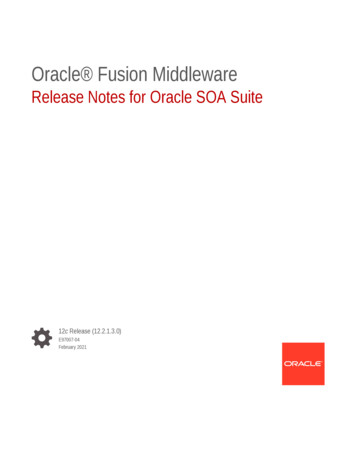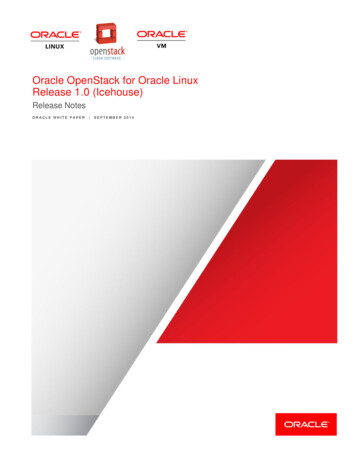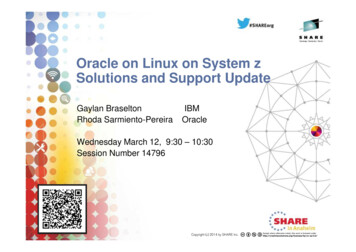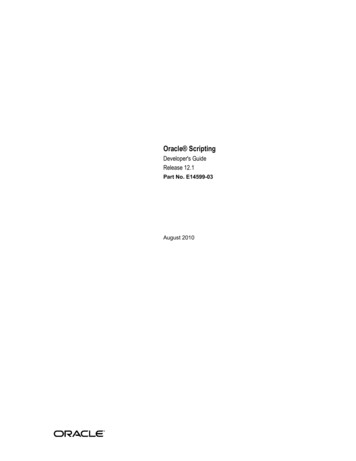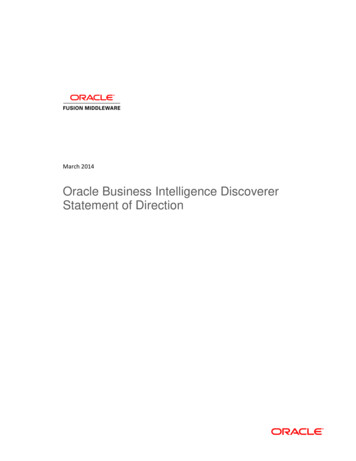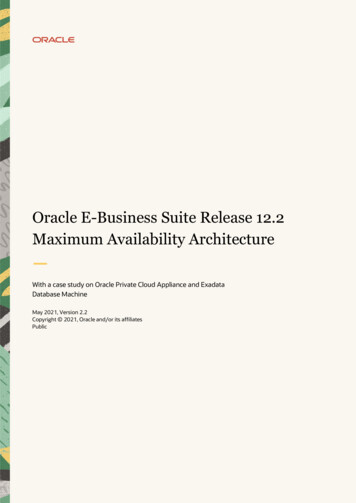
Transcription
Business / Technical BriefOracle E-Business Suite Release 12.2Maximum Availability ArchitectureWith a case study on Oracle Private Cloud Appliance and ExadataDatabase MachineMay 2021, Version 2.2Copyright 2021, Oracle and/or its affiliatesPublic1Business / Technical Brief / Oracle E-Business Suite Release 12.2 Maximum Availability Architecture / Version 1.0Copyright 2021, Oracle and/or its affiliates / Public
1 Executive Overview42 Introduction to Engineered Systems53 Oracle E-Business Suite Release 12.2 Maximum AvailabilityArchitecture63.1 Oracle Database Maximum Availability Architecture3.2 Oracle E-Business Suite Release 12.2 High Availability4 Oracle E-Business Suite Database Configuration Best Practices11154.1 OS Role Separation154.2 Database Initialization Parameters164.3 Configure Linux HugePages164.4 Take Backups of the Database Oracle Homes174.5 Handle Database Password Expiration174.6 Exadata Fast Node Death Detection174.7 Reduce Timeout on Oracle RAC Node Failure184.8 Implement Flashback Database184.9 Exadata Smart Flash Logging184.10 Exadata Smart Flash Cache184.11 Memory Management (Exadata Only)Error! Bookmark not defined.4.12 Oracle Advanced Compression194.13 Log Writer Tuning (Exadata Only)194.14 Fixed Object Statistics204.15 Exadata I/O Resource Manager (IORM)204.16 Oracle Engineered Systems Best Practices and Health Check205 Oracle E-Business Suite Release 12.2 Application TierConfiguration Best Practices215.1 Deploy Oracle E-Business Suite application tiers using Shared FileSystems215.2 Create an Oracle E-Business Suite Central Inventory on theApplication Tier215.3 Move the Apache Lock File to Local Storage225.4 Take Regular Backups of the Release 12.2 Application FileSystem226 Summary of Best Practices226.1 Best Practices – Oracle E-Business Suite Database MaximumAvailability226.2 Best Practices – Oracle E-Business Suite Application HighAvailability236.3 Best Practices – Oracle E-Business Suite Maximum Availability237 Oracle E-Business Suite MAA Case Study Architecture27247.1 Method247.2 Case Study Topology257.3 Software Versions26Business / Technical Brief / Oracle E-Business Suite Release 12.2 Maximum Availability Architecture / Version 1.0Copyright 2021, Oracle and/or its affiliates / Public
7.4 Oracle E-Business Suite Application Tier – High AvailabilityArchitecture267.5 Oracle E-Business Suite Database Tier – MAA287.6 Delegation of Roles and Administration297.7 Oracle E-Business Suite Application and Web Tier Setup307.8 Logical Host Names338 Case Study Roadmap338.1 Prepare the Network338.2 Prepare the Primary358.3 Prepare the Standby528.4 Disaster Recovery Site Test using Snapshots698.5 Test Switchover748.6 Test Failover788.7 Site Guard838.8 Patching the Database in an Engineered Systems Environment849 References9510 Appendix A: Verify Oracle E-Business Suite Required Packages9611 Appendix B: Managing SCAN for Primary and DR Sites9711.1 The custom.txt File9911.2 The ebs scan db.sh Script9911.3 The ebs scan app.sh Script10112 Appendix C: Set Web Entry Point10313 Appendix D: Add Managed Services10513.1 Review the Configuration on the Admin Server10613.2 Add and Start Managed Services10613.3 Finalize the Configuration10813.4 Bounce the HTTP Server10814 Appendix E: Perform rsync on Oracle Homes14.1 Using the rsync EBS OH.sh Script10914.2 The rsync EBS OH.sh script11115 Appendix F: Scripts used by Site Guard3109115Business / Technical Brief / Oracle E-Business Suite Release 12.2 Maximum Availability Architecture / Version 1.0Copyright 2021, Oracle and/or its affiliates / Public
1 Executive OverviewOracle Maximum Availability Architecture (MAA) is Oracle's best practice blueprint based on proven Oracle highavailability technologies and recommendations. The goal of MAA is to achieve the optimal high availabilityarchitecture at the lowest cost and complexity. Papers are published on the Oracle Technology Network (OTN) http://www.oracle.com/goto/maa.In this paper, we apply the principles of Oracle’s Maximum Availability Architecture (MAA) to the Oracle EBusiness Suite (EBS) Release 12.2 (R12.2) infrastructure. Here, we describe: EBS R12.2 MAA architecture along with installation, configuration, and operational best practices. How EBS R12.2 MAA was implemented on Oracle Private Cloud Appliance (PCA) and Exadata. Our tests to validate our best practices and measure downtime in various outage scenarios.When EBS R12.2 was configured with our MAA best practices on PCA and Exadata, we demonstrated how tominimize user impact during typical failure scenarios. In the event of a total site failure the disaster recovery sitecould be brought online in as few as 12 minutes.This paper provides a case study of Oracle E-Business Suite Release 12.2 on Oracle Private Cloud Appliance andExadata machines, showing the steps for: Reconfiguring an existing Oracle E-Business Suite R12.2 implementation to use logical host names Establishing the disaster recovery (DR) site Non-destructive testing of Oracle E-Business Suite R12.2 at the DR site Switching and failing over to the DR site Simplified patching of Oracle E-Business Suite’s Oracle Database homesThis paper was developed in the Oracle Solutions Center (OSC). The OSC is a centralized global organization withtwelve state-of-the-art locations around the world where customers architect, customize, and test solutions withOracle Cloud, Cloud@Customer, and On Premises systems in a secure, scalable, and interoperable environmentfor all deployment models. To meet evolving business and technology challenges quickly, OSC provides a widerange of accelerated services that highlight Oracle products and complementary Partner products as needed. Keyservices include Architecture Reviews, TCO/ROI Analyses, Proofs of Concepts, Customized Demonstrations andWorkshops to support a dynamic community of VAD/VAR, ISVs, and System Integrators.If you are considering High Availability, Disaster Recovery, and Data Center Consolidation using Oracle'sMaximum Availability Architecture (MAA), the OSC is the place to test, validate and perfect your organization’sDisaster Recovery needs. At the OSC, meet the experts and leverage Oracle's best practices with any combinationof technologies, hosted by Oracle subject matter experts and Solution Architects. Contact your local accountmanager to engage the Oracle Solutions Center and benefit from its range of capabilities and competencies toeffortlessly solve your business technology challenges.4Business / Technical Brief / Oracle E-Business Suite Release 12.2 Maximum Availability Architecture / Version 1.0Copyright 2021, Oracle and/or its affiliates / Public
2 Introduction to Engineered SystemsOracle’s Engineered Systems combine best-of-breed hardware and software components with game-changingtechnical innovations. Designed, engineered, and tested to work best together, Oracle’s Engineered Systems canpower the cloud or streamline data center operations to make traditional deployments even more efficient. Thecomponents of Oracle’s Engineered Systems are preassembled for targeted functionality and then—as acomplete system—optimized for extreme performance. By taking the guesswork out of these highly available,purpose-built solutions, Oracle delivers a solution that is integrated across every layer of the technology stack—asimplicity that translates into less risk and lower costs for your business. Only Oracle can innovate and optimizeat every layer of the stack to simplify data center operations, drive down costs, and accelerate businessinnovation.2.1.1 Oracle Private Cloud ApplianceOracle Private Cloud Appliance and Oracle Private Cloud at Customer are on-premise cloud-native convergedinfrastructures that allow customers to efficiently consolidate business-critical middleware and applicationworkloads. Oracle Private Cloud Appliance is cost effective, easy to manage, and delivers better performancethan disparate build-your-own solutions. Oracle Private Cloud Appliance and Oracle Exadata together provide apowerful, single-vendor application and database platform for today’s data driven enterprise.Oracle Private Cloud Appliance runs enterprise workloads alongside cloud-native applications to support a varietyof application requirements. Its built-in secure multi tenancy, zero downtime upgradability, capacity on demandand single pane of glass management make it the ideal infrastructure for rapid deployment of mission criticalworkloads. Oracle Private Cloud Appliance and Oracle Cloud Infrastructure together provide customers with acomplete solution to securely maintain workloads on both private and public clouds.2.1.2 Oracle Exadata Database MachineOracle’s Exadata Database Machine is Oracle’s database platform delivering extreme performance for databaseapplications including Online Transaction Processing, Data Warehousing, Reporting, Batch Processing, orConsolidation of mixed workload databases. Exadata is a pre-configured, pre-tuned, and pre-tested integratedsystem of servers, networking, and storage all optimized around the Oracle Database. Because Exadata is anintegrated system, it offers superior price-performance, availability, and supportability. Exadata frees users fromthe need to build, test, and maintain systems and allows them to focus on higher-value business problems.Key highlights of the Exadata architecture:5 Exadata uses a scale-out architecture for database servers and storage. This architecture maintains anoptimal storage hierarchy from memory to flash to disk. Smart Scan query offload has been added to the storage cells to offload database processing Exadata implements Smart Flash Cache as part of the storage hierarchy. Exadata software determineshow and when to use the Flash storage for reads and write as well as how best to incorporate Flash intothe database as part of a coordinated data caching strategy. A high-bandwidth low-latency InfiniBand network running specialized database networking protocolsconnects all the components inside an Exadata Database Machine. Newer generations of Exadata,starting with X8M, now implement a much higher bandwidth and extremely lower latency network calledRDMA over Converged Ethernet or RoCE. Coupled with Persistent Memory (PMEM) on the storage cells,direct memory access from a compute node using RDMA to a given storage server is as low as 19microseconds. In addition to a high performance architecture and design, Exadata offers the industry’s best datacompression to provide a dramatic reduction in storage needs.Business / Technical Brief / Oracle E-Business Suite Release 12.2 Maximum Availability Architecture / Version 1.0Copyright 2021, Oracle and/or its affiliates / Public
3 Oracle E-Business Suite Release 12.2 Maximum Availability ArchitectureOracle E-Business Suite Maximum Availability Architecture (MAA) is an EBS high availability (HA) architecturelayered on top of the Oracle Database Maximum Availability Architecture, including a secondary site to providebusiness continuity in the event of a primary site outage.In this section, we first present the Oracle Database Maximum Availability Architecture, then we describe how toprovide high availability for Oracle E-Business Suite on top of that foundation, resulting in a full Oracle E-BusinessSuite MAA implementation.Figure 1 Oracle E-Business Suite Release 12.2 full MAA implementationFigure 1 illustrates a full MAA implementation of an Oracle E-Business Suite Release 12.2 deployment consistingof two separate sites - a primary site and a disaster recovery site. At the primary site, Oracle Real ApplicationClusters (Oracle RAC) ensures high availability of the database tier, and multiple application tier servers providehigh availability for Oracle E-Business Suite users and applications. Database replication to the disaster recoverysite is achieved using Oracle Data Guard. Application tier file system replication is achieved using storagereplication, rsync, or any other common UNIX/Linux tool. The disaster recovery site is identical to the primary sitein terms of system infrastructure.6Business / Technical Brief / Oracle E-Business Suite Release 12.2 Maximum Availability Architecture / Version 1.0Copyright 2021, Oracle and/or its affiliates / Public
3.1 Oracle Database Maximum Availability ArchitectureFigure 2 Oracle Database Maximum Availability ArchitectureTo achieve maximum Oracle E-Business Suite database availability, Oracle recommends deploying E-BusinessSuite on an Oracle Database MAA foundation that includes the following technologies as shown in Figure 2: Oracle Real Application Clusters and Oracle Clusterware Oracle Data Guard Oracle Flashback Database Oracle Automatic Storage Management Oracle Recovery Manager and Oracle Secure Backup Oracle Online Upgrade Using Edition Based RedefinitionThe rest of this section briefly describes each of these components. For further information, refer to OracleDatabase High Availability Overview for a thorough introduction to Oracle Database high availability products,features, and best practices.3.1.1 Oracle Real Application Clusters and Oracle ClusterwareOracle Real Application Clusters (Oracle RAC) enables the Oracle Database to serve any packaged or customapplication unchanged across a set of clustered nodes. This capability provides the highest levels of availabilityand maximum scalability. If a clustered node fails, the Oracle Database continues to run on the surviving nodes.When more processing power is needed, another node can be added without interrupting database operations oruser access. For further information, refer to Oracle Real Application Clusters Administration and DeploymentGuide.Oracle Clusterware is a cluster manager specifically designed for the Oracle Database. In an Oracle RACenvironment, Oracle Clusterware monitors all Oracle resources, such as database instances and associatedlisteners. If a failure occurs, Oracle Clusterware automatically attempts to restart the failed resource. Duringoutages, Oracle Clusterware will relocate the processing performed by the inoperative resource to an alternateresource. For example, if a database node fails, Oracle Clusterware will relocate the database services being usedby the application to a surviving node in the cluster.For further information, refer to Clusterware Administration and Deployment Guide.3.1.2 Oracle Multitenant7Business / Technical Brief / Oracle E-Business Suite Release 12.2 Maximum Availability Architecture / Version 1.0Copyright 2021, Oracle and/or its affiliates / Public
Oracle Multitenant was introduced in Oracle RDBMS 12c. Oracle Multitenant enables the segmentation of datainto separate self-contained pluggable databases. A container database and the one or more pluggable databasehosted by that container all share the same infrastructure resources, such background processes, memory, CPU,IO, and networking. We can move pluggable databases from one container database to another, providingdatabase virtualization. The following diagram illustrates a simplified form of a single container database (CDB)with three pluggable databases (PDBs).Please note that E-Business Suite must be deployed as single PDBs into 19c or higher container databases. Atpresent, E-Business Suite does not support its database running in a container with more than one PDB.Figure 3: Container database with three pluggable databasesFigure 3 above illustrates the following: A single container database (CDB) Three pluggable databases (PDB) named: FIN, HCM and Portal (note: not supported by EBS) The FIN and HCM PDBs are plugged into the CDB root also known as CDB ROOT. The Portal PDB is unplugged from the CDB root. Pluggable databases can be unplugged from one CDB and plugged into another. This provides dataportability.Other features of Oracle Multitenant are: Portability via plug and unplug – the application runs unchanged. PDB upgrade via plug and unplug The database code is patched once for all PDBs in the CDB. Common operations such as backup, restore, and flashback can be done at the CDB or the PDB level. PDBs can be opened or closed on a per RAC instance basis Multiple PDBs hosted on a single CDB allows greater consolidation while keeping data securely segregated.Note that at this time Oracle E-Business Suite does not support multiple PDBs in a single CDB.3.1.3 Oracle Data Guard8Business / Technical Brief / Oracle E-Business Suite Release 12.2 Maximum Availability Architecture / Version 1.0Copyright 2021, Oracle and/or its affiliates / Public
Oracle Data Guard provides a comprehensive set of services that create, maintain, manage, and monitor one ormore standby databases to enable production Oracle Databases to survive failures, disasters, and physical orlogical block corruption. Data Guard maintains these standby databases as transactionally consistent copies ofthe production database. If the production database becomes unavailable due to a planned or an unplannedoutage, Data Guard can switch any standby database to the production role, thus greatly reducing the applicationdowntime caused by the outage. Data Guard can be used with traditional backup, restore, and clusteringsolutions to provide a high level of data protection and data availability.Oracle E-Business Suite supports physical standby databases. A physical standby database provides a physicallyidentical copy of the primary database, with on-disk database structures that are identical to the primary databaseon a block-for-block basis. A physical standby database is kept synchronized with the primary database usingRedo Apply, which applies the redo received from the primary database to the physical standby database.With Oracle Active Data Guard, a physical standby database can receive and apply redo while it is open for readonly access, so it may be used for other purposes as well as disaster recovery. The Oracle E-Business Suitesupports a limited but critical set of Oracle Active Data Guard functions, including automatic block repair and fastincremental backups. For further information, refer to MOS Doc ID 1944539.1, “Using Active Data Guard Reportingwith Oracle E-Business Suite Release 12.2 and an Oracle 11g or 12c Database".A physical standby database can be converted into a Snapshot Standby with a single command. It will temporarilybecome an independent database (open read-write), creating an ideal testbed for short-term uses such as testingapplication upgrades. The Snapshot Standby will continue to receive and archive (but not apply) redo data fromthe primary database while it is open read-write, protecting the primary data at all times. When testing iscomplete, a single command converts the snapshot back into a standby database, using Flashback Databasefunctionality to roll back all changes made to the snapshot then automatically resynchronizing it with the primaryby rolling forward through the redo received from the primary.For more information about Oracle Data Guard, including Snapshot Standby, see Data Guard Concepts andAdministration.3.1.4 Oracle Data Guard BrokerOracle Data Guard Broker is a command-line interface that enables easy and automated configuration of anOracle Data Guard environment. It provides for simplified management and monitoring of the Data Guardconfiguration. Orchestration of role transitions for switchover or failover are managed by Oracle Data GuardBroker with a single simple command. For Data Guard Broker documentation, see Oracle Data Guard Broker.3.1.5 Oracle Flashback DatabaseOracle Flashback quickly rewinds an Oracle database, table, or transaction to a previous point in time, to helpcorrect problems caused by logical data corruption or user error, or to reset a test database between runs. It is likea 'rewind button' for your database.Some features of Oracle Flashback are not supported in a production Oracle E-Business Suite environment unlessunder direct guidance from Oracle Support. Specifically, while in some cases it might seem useful to flash aspecific transaction or table back to a prior point in time, this cannot be done in a production E-Business Suiteenvironment except under severe data recovery situations. However, Oracle Flashback Database can beparticularly useful in Oracle E-Business Suite test environments, to recover from bugs discovered when testingsoftware changes, unwind a patch, or to rewind the database between test runs. Oracle Flashback Database canalso be used to rapidly return a previous failed primary database to standby operation after a Data Guard failover,eliminating the need to recopy or re-instantiate the entire database from a backup.The use of Large Objects (LOBs) with Oracle Flashback Database can result in performance overhead. SeveralOracle E-Business Suite modules use LOBs, so you should measure Oracle Flashback Database performance withyour expected LOB maintenance activity, to ensure the solution will performs adequately in your productionenvironment.9Business / Technical Brief / Oracle E-Business Suite Release 12.2 Maximum Availability Architecture / Version 1.0Copyright 2021, Oracle and/or its affiliates / Public
Regardless of whether you enable Flashback Database in production, using Oracle Flashback Database isrecommended for testing the disaster recovery site using Snapshot Standby.See “Oracle Flashback Technology” in Oracle Database Concepts for more information. For Flashback Database best practicessee MOS Doc “Flashback Database Best Practices & Performance (Doc ID 565535.1)”.3.1.6 Oracle Automatic Storage ManagementOracle Automatic Storage Management (ASM) provides a vertically integrated file system and volume managerdirectly in the Oracle kernel, resulting in: Significantly less work to provision database storage High levels of availability Elimination of the expense, installation, and maintenance of specialized storage products Automatic resilvering of mirrors to recover from physical hardware issues Proactive detection and repair of physically corrupted blocks, and of blocks that have certain logicalcorruptions Automatic rebalancing of contents as needed after disk group maintenanceFor optimal performance, ASM distributes data files across all available storage. To protect against data loss, ASMextends the concept of SAME (Stripe And Mirror Everything) and adds more flexibility in that it can mirror at thedatabase file level rather than the entire disk level.For more details, see Automatic Storage Management Administrator's Guide.3.1.7 Oracle Recovery Manager and Oracle Secure BackupOracle Recovery Manager (RMAN) is an Oracle Database utility that can back up, restore, and recover databasefiles. It is a feature of Oracle Database and does not require a separate installation. RMAN integrates withsessions running on an Oracle database to perform a range of backup and recovery activities, includingmaintaining a repository of historical data about backups.Oracle Secure Backup (OSB) is a centralized tape backup management solution providing performant,heterogeneous data protection in distributed UNIX, Linux, Windows, and Network Attached Storage (NAS)environments. By protecting file system and Oracle Database data, OSB provides a complete tape backupsolution for your IT environment. OSB is tightly integrated with RMAN to provide the media management layerfor RMAN.For more details, see Database Backup and Recovery User's Guide.3.1.8 Online Upgrades Using Edition Based RedefinitionEdition-Based Redefinition (EBR) was introduced with Oracle Database 11g, and enables the database’sparticipation in online application patches and upgrades in the following manner: Schema changes and application code changes stored in the database are installed in the privacy of a newedition. Data changes are made safely by writing only to new columns or new tables not seen by the old edition. Aneditioning view exposes a different projection of a table into each edition to allow each to see just its owncolumns. A cross edition trigger propagates data changes made by the old edition into the new edition’s columns.EBR is one of the key features utilized in Oracle E-Business Suite Release 12.2 for its online application patching.This is discussed in the section “Oracle E-Business Suite R12.2 Online Patching”. Later, this paper describes howthe disaster recovery site can be used to test an Oracle E-Business Suite patch or upgrade before finalizing themaintenance event in production. This allows you to make further changes or even abandon the system changesmade by an EBS patch.10 Business / Technical Brief / Oracle E-Business Suite Release 12.2 Maximum Availability Architecture / Version 1.0Copyright 2021, Oracle and/or its affiliates / Public
For more details on Edition Based Redefinition, see the chapter: “Using Edition Based Redefinition” in theDatabase Development Guide.3.2 Oracle E-Business Suite Release 12.2 High AvailabilityThe distribution of Oracle E-Business Suite managed services across multiple applications nodes enablesapplication-level Oracle E-Business Suite high availability. To accomplish this, you can add application tier nodesto scale up the application tier. The additional Oracle E-Business Suite instances are typically located ondedicated machines to increase the availability and flexibility of the system.The Oracle E-Business Suite application tier availability features include: Parallel Concurrent Processing Multiple load balanced application tier services Oracle E-Business Suite Release 12.2 Online Patching Logical host names (new as of AD/TXK Delta 9) Fusion MiddleWare Administration Server configuration Each of these is expanded in the following sections. Figure 3 illustrates this architecture.Figure 4 Oracle E-Business Suite High Availability Architecture3.2.1 Parallel Concurrent Processing (PCP)Parallel concurrent processing allows the distribution of concurrent managers (the core component of the batchprocessing application services) across multiple application nodes in a clustered, parallel, or networkedenvironment. Instead of operating concurrent processing on a single node, the concurrent processing workloadcan be distributed and balanced across all available nodes.Parallel concurrent processing provides the following capabilities and performance benefits for Oracle E-BusinessSuite:11 Business / Technical Brief / Oracle E-Business Suite Release 12.2 Maximum Availability Architecture / Version 1.0Copyright 2021, Oracle and/or its affiliates / Public
High performance – the ability to run concurrent processes on multiple application nodes to improveconcurrent processing throughput and make concurrent processing highly scalable. Fault Tolerance - the ability to continue running concurrent processes on available nodes even when one ormore application nodes fail. Adaptability - the ability to integrate with platform-specific batch queue and load-balancing systems tomaximize concurrent processing behavior on a particular platform. Single Point of Control - the ability to administer concurrent managers running on multiple application nodesfrom any node in the middle tier cluster. Database load balancing and/or load direction – the ability to spread or direct the load across the databaseinstances. You can configure all or most of your workload to run on any application server and configureeach application server to run against any database instance, or you can configure certain concurrentprograms or groups of programs to run on a particular application server, and configure that applicationserver to run against a specific database instance. The amount of benefit experienced by controlling whichdatabase instance specific programs run against depends on the programs’ data access and update profile.While there are clearly some trade-offs such as additional planning and configuration, grouping certainconcurrent manager programs onto specific servers by product can reduce the latency incurred by contentionand block shipping between nodes across the Oracle RAC interconnect.Parallel concurrent processing handles failover to a surviving database RAC instance in the same way as it handlesfailure of an application tier server – restarting its concurrent managers on an application tier node where there isan available connection to a surviving database instance.Note that an SMTP server is required on each application node hosting a concurrent manager, for use by theOracle E-Business Suite Workflow Mailer.For further information refer to MOS Docs “Concurrent Processing - Best Practices for Performance forConcurrent Managers in E-Business Suite (Doc ID 1057802.1)” and “Concurrent Processing - Product InformationCenter (PIC) (Doc ID 1304305.1).”To create a high availability configuration of the Oracle E-Business Suite Workflow Mailer, define a primary andsecondary node for the Workflow Mailer Service Manager using the Workflow Mailer Service form as shown inFigure 5.Figure 5 Oracle E-Business Suite Form for the Workflow Mailer Service12 Business / Technical Brief / Oracle E-Business Suite Release 12.2 Maximum Availability Architecture / Version 1.0Copyright 2021, Oracle and/or its affiliates / Public
3.2.2 Multiple Load-Balanced Application Tier ServicesOracle E-Business Suite Release 12.2 uses Fusion Middleware (FMW) components, deployed as a WebLogicServer (WLS) cluster. User requests are safely routed to the appropriate FMW component in that cluster by OracleHTTP Server (OHS).The WLS cluster will host three application tier components, each in its own managed service group: OACORE services (“Self Service”) Forms services OAFM for other web servicesEach managed service group can be distributed across two or more physical or VM servers, allowing for both highavailability and scalability. Managed services can be added or removed from the cluster as needed.We recommend that more than one of each type of managed service be deployed, on separate physical servers,
EBS R12.2 MAA architecture along with installation, configuration, and operational best practices. How EBS R12.2 MAA was implemented on Oracle Private Cloud Appliance (PCA) and Exadata. Our tests to validate our best practices and measure downtime in various outage scenarios. When EBS R12.2 was configured with our MAA best practices on PCA and .

